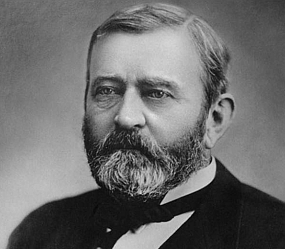In a move that prevented open war across the Northern Plains, President Ulysses S. Grant issued an executive order extending the deadline set previously for all Native Americans to return to their reservations. The initial date for the deadline had been carefully calculated two months before by Grant and his generals Philip Sheridan, commander of the Division of the Missouri, and George Crook, commander of the Department of the Platte, to be unreachable by the Indians, who had settled into their winter quarters. When the Indians did not move (General Sheridan noted that the Indians would not move no matter the date, though Lakota leaders had already decided they would travel to the agencies that spring), they would march troopers into the Indian camps and force them into submissive positions on the reservations.
The matter at the core was gold. White encroachment on Indian lands had gone on for decades, and the Indians had gradually migrated and dealt with the growing White settlement. Several wars had raged, but none were as large as the surprise attack Sheridan and Crook were planning to clear the Indians quickly and effectively out of the Black Hills, where gold had been discovered by the Custer Expedition in 1874. A gold rush was in full sway and expected to boom. The Federal government had ended stopping trespassers onto the Sioux hunting grounds as an initial part of the plan and offered to pay the tribes $25,000 and reservations south in Indian Territory. Spotted Tail summarized the feelings of the Sioux leaders who had traveled to Washington with, “You speak of another country, but it is not my country; it does not concern me, and I want nothing to do with it. I was not born there.”
Yet, the land was needed both to open for the glut of would-be miners following the Panic of 1873 as well as for railroad projects. Grant had previously reversed the objectives of the Federal government, which had been anti-Indian since its founding. Johnson’s order to General Sheridan years before about the Cheyenne and Arapaho had been, “I want you to go ahead, kill and punish the hostiles, capture and destroy the ponies.” Grant later confronted Congress on the policies, saying, “Wars of extermination are demoralizing and wicked” and “A system which looks to the extinction of a race is too horrible for a nation to adopt without entailing upon itself the wrath of all Christendom.” Despite his advances in upholding treaties, in his second term the question of the Black Hills had turned him to the same policies he had derided.
In late January, a telegram from the US Indian Agent at Standing Rock reached the president, saying that his requests to extend the deadline had been repeatedly denied despite that travel in the midst of winter was impossible. He noted that any God-fearing, decent man would be reasonable rather than start a war, and Grant felt his spark of conscious. The Whiskey Ring scandal that had implicated his secretary Orville E. Babcock had destroyed Grant’s popularity among Republicans, and he decided that acting in favor of the Indians could not do any more damage, saying famously, “If I’m going to be unpopular, I might as well do the right thing.”
In spring of 1876, the majority of the Indians came to their reservations as had been agreed. Sheridan and Crook were allowed to mop up the stragglers and then ordered to maintain some kind of peace amid the Indians and the swarms of prospectors centering on Deadwood. Methods of herding the remaining buffalo were organized by the Sioux and government agents, who finally were able to work a deal for the Northern Pacific Railroad giving the Indians a toll based on transport. When the gold began to give out, the prospectors deserted, and the Sioux gradually came back into control over much of the area. Conservationist Theodore Roosevelt hunted the buffalo in 1893, and his political actions back East helped give funding to rebuilding the Northern Buffalo Herd, which had been barely saved from the extinction that had struck the Southern.
Despite decades more of politics and needless violence, the White and Native Americans gradually learned to live alongside one another, perhaps best exemplified by the peaceful demonstrations at Wounded Knee in 1890 where invited government officials understood the severity of breaking up the Great Sioux Reservation and determined to honor the previous treaty.
–
In reality, the request for extension was firmly denied. The Great Sioux War began, leading to nearly double the casualties of American soldiers as Sioux (such as in the disastrous Battle of Little Bighorn), but firmly establishing the US Army’s control over the Indians. The buffalo were systematically eradicated, leaving the Native Americans no choice but to depend upon the Federal Agencies for supplies. Policies of assimilation continued for decades on the reservations, especially after the cultural misunderstanding of the Ghost Dance that led to the Massacre at Wounded Knee.

The Indians should have had stricter immigration policies back in the 1600s.
ReplyDelete